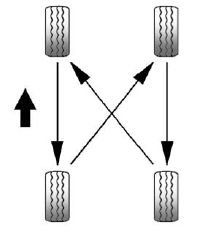Tire Rotation
Tires should be rotated every 12 000 km (7,500 mi).
See Maintenance Schedule on page 11‑3.
Tires are rotated to achieve a uniform wear for all tires.
The first rotation is the most important.
Any time unusual wear is noticed, rotate the tires as soon as possible and check the wheel alignment. Also check for damaged tires or wheels.
See When It Is Time for New Tires on page 10‑51 and Wheel Replacement on page 10‑56.

Use this rotation pattern when rotating the tires.
If the vehicle has a compact spare tire, do not include it in the tire rotation.
Adjust the front and rear tires to the recommended inflation pressure on the Tire and Loading Information label after the tires have been rotated.
See Tire Pressure on page 10‑44 and Vehicle Load Limits on page 9‑10.
Reset the Tire Pressure Monitor System. See Tire Pressure Monitor Operation on page 10‑46.
Check that all wheel nuts are properly tightened. See “Wheel Nut Torque” under Capacities and Specifications on page 12‑2.
WARNING
Rust or dirt on a wheel, or on the parts to which it is fastened, can make wheel nuts become loose after time. The wheel could come off and cause an accident. When changing a wheel, remove any rust or dirt from places where the wheel attaches to the vehicle.
In an emergency, a cloth or a paper towel can be used;
however, use a scraper or wire brush later to remove all rust or dirt.
Lightly coat the center of the wheel hub with wheel bearing grease after a wheel change or tire rotation to prevent corrosion or rust build-up. Do not get grease on the flat wheel mounting surface or on the wheel nuts or bolts.
Check that the spare tire, if the vehicle has one, is stored properly. Push, pull, and then try to rotate or turn the tire. If it moves, tighten the cable. See Tire Changing on page 10‑68.
See also:
Reclining Seatbacks
WARNING
Sitting in a reclined position when the vehicle is in motion can be dangerous. Even when buckled up, the safety belts cannot do their job when reclined like this.
The safety belt cannot prop ...
Starter Switch Check
WARNING
When you are doing this inspection, the vehicle could move suddenly. If the vehicle
moves, you or others could be injured.
1. Before starting this check, be sure there is enough room aroun ...
Playing the Radio
For vehicles equipped with the MyLink or IntelliLink infotainment system, see
the separate MyLink/ IntelliLink Features and Functions Guide for more information.
Audio Source
VOL/ (Power/Volume): ...





